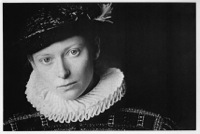Difference between revisions of "Androgyny"
(Created page with 'File:lighterstill.jpgright|frame ==Origin== Latin ''androgynus'' hermaphrodite, from [http://en.wikipedia.org/wiki/Ancient_Greek Ancie...') |
m (Text replacement - "http://" to "https://") |
||
| Line 2: | Line 2: | ||
==Origin== | ==Origin== | ||
| − | [[Latin]] ''androgynus'' hermaphrodite, from [ | + | [[Latin]] ''androgynus'' hermaphrodite, from [https://en.wikipedia.org/wiki/Ancient_Greek Ancient Greek]: ἀνδρόγυνος, from ἀνήρ, stem ἀνδρ- (anér, ''andr''-, [[meaning]] man) and γυνή (''gunē'', ''gyné'', meaning [[woman]]). |
| − | *[ | + | *[https://en.wikipedia.org/wiki/17th_century 1651] |
==Definitions== | ==Definitions== | ||
*1: having the characteristics or [[nature]] of both [[male]] and [[female]] | *1: having the characteristics or [[nature]] of both [[male]] and [[female]] | ||
| Line 12: | Line 12: | ||
'''Androgyny''' refers to the combination of [[masculine]] and [[feminine]] characteristics. Sexual [[ambiguity]] may be found in [[fashion]], [[gender]] [[identity]], sexual identity, or sexual [[lifestyle]]. It could also refer to biological intersex physicality, especially with regards to [[plant]] and human [[sexuality]]. | '''Androgyny''' refers to the combination of [[masculine]] and [[feminine]] characteristics. Sexual [[ambiguity]] may be found in [[fashion]], [[gender]] [[identity]], sexual identity, or sexual [[lifestyle]]. It could also refer to biological intersex physicality, especially with regards to [[plant]] and human [[sexuality]]. | ||
| − | ''Androgyny'' and [[homosexuality]] are seen in [ | + | ''Androgyny'' and [[homosexuality]] are seen in [https://en.wikipedia.org/wiki/Plato's_Symposium Plato’s Symposium] in a [[myth]] that [https://en.wikipedia.org/wiki/Aristonphanes Aristophanes] tells the [[audience]]. People used to be spherical creatures, with two bodies attached back to back who cartwheeled around. There were three sexes: the male-male people who descended from the sun, the female-female people who descended from the earth, and the male-female people who came from the [[moon]]. This last pairing represented the ''androgynous'' couple. These sphere people tried to take over the gods and failed. [https://en.wikipedia.org/wiki/Zeus Zeus] then decided to cut them in half and had [https://en.wikipedia.org/wiki/Apollo Apollo] stitch them back together leaving the navel as a reminder to not defy the gods again. If they did, he would cleave them in two again to hop around on one leg. Plato states in this work that homosexuality is shameless. This is one of the earlier written references to ''androgyny''.[https://en.wikipedia.org/wiki/Androgyny] |
[[Category: Biology]] | [[Category: Biology]] | ||
[[Category: Mythology]] | [[Category: Mythology]] | ||
Latest revision as of 23:45, 12 December 2020
Origin
Latin androgynus hermaphrodite, from Ancient Greek: ἀνδρόγυνος, from ἀνήρ, stem ἀνδρ- (anér, andr-, meaning man) and γυνή (gunē, gyné, meaning woman).
Definitions
- 1: having the characteristics or nature of both male and female
- 2a : neither specifically feminine nor masculine <the androgynous pronoun them>
- b : suitable to or for either sex <androgynous clothing>
- 3: having traditional male and female roles obscured or reversed <an androgynous marriage>
Description
Androgyny refers to the combination of masculine and feminine characteristics. Sexual ambiguity may be found in fashion, gender identity, sexual identity, or sexual lifestyle. It could also refer to biological intersex physicality, especially with regards to plant and human sexuality.
Androgyny and homosexuality are seen in Plato’s Symposium in a myth that Aristophanes tells the audience. People used to be spherical creatures, with two bodies attached back to back who cartwheeled around. There were three sexes: the male-male people who descended from the sun, the female-female people who descended from the earth, and the male-female people who came from the moon. This last pairing represented the androgynous couple. These sphere people tried to take over the gods and failed. Zeus then decided to cut them in half and had Apollo stitch them back together leaving the navel as a reminder to not defy the gods again. If they did, he would cleave them in two again to hop around on one leg. Plato states in this work that homosexuality is shameless. This is one of the earlier written references to androgyny.[1]
